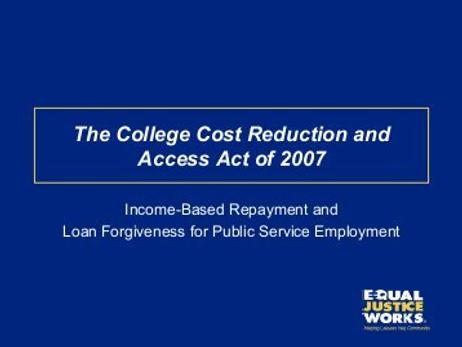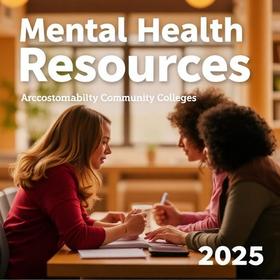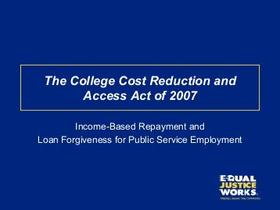The College Cost Reduction and Access Act of 2007 ("CCRAA" or the "Act") was enacted to make college more affordable for low- and moderate-income students by phasing in increases in government grants. For example, in 2007, the maximum Pell Grant was limited to $4,310, whereas the maximum for 2012 was $5,400. The Act also decreases interest rates on government-backed loans and even cancels outstanding debt in certain situations. The favorable terms for grants and loans represent an important step in achieving universal access to higher education. This report examines the problem of inadequate college assistance, the enactment of the Act, the major provisions affecting college student borrowers, and the funding of the new benefits.
The Rising Cost of Higher Education Leads to Massive Student Loan Debt
Federal student aid has not kept pace with the escalating cost of higher education and the reduced state support of public colleges and universities. As a result, some students decide that a college education is out of their reach. Other students and their families borrow more to pay tuition and other expenses. Students who graduate with unpaid loans are burdened with thousands of dollars of debt that they must usually begin repaying shortly after graduation. Studies show that about 39 percent of college graduates under 35 say paying off their loans will take more than ten years. For graduates with low- or moderate-paying jobs, the monthly principal and interest due may far exceed their ability to pay.
Attending a community college is a way to reduce the overall cost of higher education. Nevertheless, 34 percent of community college students receive federal grants or loans. Their debt may increase if they pursue a bachelor's degree or graduate school.
Plenty of guidelines advise students to make sure their future loan payments will not exceed ten percent of their monthly gross income. For many students, those guidelines do not seem realistic, and they continue borrowing without pinning down their future liabilities and ability to pay. Sadly, some graduates, in retrospect, regret their choices to borrow, especially when their hopes of lucrative jobs do not materialize.
As public concern mounted over the lack of affordable education and unmanageable post-graduation debt, our elected officials were compelled to provide some relief.
Enactment of the CCRAA
The legislation to create the CCRAA passed quickly from bill to law with bipartisan support in both House and Senate. Rep. George Miller (D-CA), Chairman of the House Education and Labor Committee, drafted the initial bill (H.R. 2669) with input from Ranking Member Howard P. McKeon (R-CA). The House passed it on July 11, 2007. The Senate passed its version of the Act on July 20, 2007. A conference committee report to resolve differences between the House and Senate versions, and to ward off a threatened Presidential veto, was approved on September 7, 2007 (PL 110-84).
President George W. Bush signed the CCRAA into law on September 27, 2007. At the signing ceremony, the President stated that the new law "will help millions of low-income Americans earn a college degree." Rep. Miller described the Act as the "greatest investment to help students and parents pay for college since the G.I. Bill." Numerous groups have acclaimed the legislation, including the National Education Association, the National Association of State Universities and Land-Grant Colleges, and the American Association of Community Colleges.
Benefits of the Act
The benefits added by the CCRAA take many forms, including increased grants, lower interest rates, and loan forgiveness. The Act is generally effective October 1, 2007; however, specific provisions of the Act have later effective dates. The significant provisions are discussed below.
Pell Grants Extended
The Pell Grant Program provides need-based grants to low-income college students. Pell Grants are an important form of financial aid because, unlike loans, grants do not have to be repaid. Federal Pell Grants were introduced in 1972 and were authorized through the fiscal year 2004. The CCRAA extended the authorization until the fiscal year 2017. More than two million community college students receive federal Pell Grants annually.
Pell Grants Increased
The amount of a Pell Grant is determined for each student based on several factors, including the parents' financial status. The Pell Grant for 2007 was $4,310. The CCRAA increases the maximum Pell Grants over the next five years as follows:
2008 – 2009 $4,800
2010 – 2011 $5,000
2012 $5,400
Removes Tuition Sensitivity in Calculating Pell Grants
Under the Higher Education Act, the amount of a student's tuition had to be considered in determining the amount of the student's Pell Grant. The result was that students attending colleges with low tuition received smaller grants than other students. The "tuition sensitivity" requirement was removed by the CCRAA, effective for determining Pell Grant amounts for award years beginning on or after July 1, 2007. Thus, low-income students are no longer penalized for attending cost-efficient schools with low tuition.
Reduced Interest Rates for Stafford Loans
Stafford loans are subsidized and unsubsidized loans from the federal government. Borrowers do not owe interest on subsidized loans while still in school. In contrast, interest on unsubsidized loans accrues while the student is in school and is added to the principal balance when the loans become payable. Effective July 1, 2008, CCRAA substantially reduced the interest rates that apply to subsidized Stafford loans. The current interest rate on Stafford loans is 6.8 percent. The decrease will be phased in as follows:
1st disbursement made on or after the Interest rate
July 1, 2008, 6.0%
July 1, 2009, 5.6%
July 1, 2010, 4.5%
July 1, 2011, 3.4%
The decreased rates do not apply to outstanding loans, but students getting their first disbursements on or after July 1, 2008, will begin taking advantage of the lower interest rates. The reduced rates also apply to other subsidized federal loans.
Income-Based Repayment
Directly addressing the issue of unmanageable debt, the CCRAA caps the amount a borrower has to pay on student loans concerning the person's income. Effective July 1, 2009, the maximum monthly loan payment is limited to 15 percent of the borrower's discretionary income. Discretionary income is when the person's adjusted gross income exceeds 150 percent of the federal poverty line applicable to the borrower's family. Thus, no payments are required so long as a borrower makes less than 150 percent of the poverty line. (For 2007, the poverty line for a family of four was $20,650.) When a borrower qualifies for the special cap, any outstanding loan balance remaining after 25 years is canceled.
Knowing they will face a mountain of debt after graduation, some students feel compelled to major in areas leading to a high-paying career. The hope is that income-based repayment will encourage students to pursue their real interests, even if careers in the major of their choice don't provide a high income.
Public Service Employees
To encourage and reward public service, public service employees are entitled to have the outstanding balance of their loans canceled after making loan payments for ten years under certain payment plans. Numerous occupations are treated as public service jobs, including emergency management, government, military service, public safety, law enforcement, social work, child care, public education, public health, public service for the elderly and disabled, and librarians.
Other Provisions
CCRAA addresses numerous other college assistance aspects highlighted in this report. For example, provisions of the Act pertain to TEACH grants, deferment for members of the Armed Forces, increasing income protection allowance for working students, authorizing funds certain for Upward Bound projects, new support for Historically Black Colleges and Universities, and other minority-serving institutions, a matching challenge grant program with philanthropic organizations, and creating a Competitive Loan Auction Pilot program.
Economic Impact
One of the selling points of the Act is that its substantial benefits are provided without any budget increases. The increased grants, interest rate decreases, loan forgiveness, and other benefits under the CCRAA are estimated to total almost $20 billion dollars. The benefits will be funded primarily by decreasing $18.75 billion in subsidies and other benefits formerly available to private lenders and guarantee agencies. The concern underlying the change is that loan companies have used government subsidies to increase their profits without passing along anything to borrowers through reducing interest rates.
Criticisms
Not everyone views the historic Act favorably. Detractors of the CCRAA believe that far more student aid is needed than the Act provides, especially for low-income families. For example, the increase in the Pell Grants of only $500 is inadequate to cover the costs facing low-income college students. Many view the Act as a first step, rather than a solution, to making college affordable for all Americans.
Lenders of federally backed loans strongly opposed the CCRAA. The lenders allege that some small- to medium-sized lenders will be forced out of business without subsidies and that the decreased competition will harm students in the long run. Some have questioned why loan forgiveness is provided to public service workers and not to private sector employees.
Conclusion
The CCRAA represents a highly significant commitment by the federal government to make a college education affordable for all.
Questions? Contact us on Facebook. @communitycollegereview















